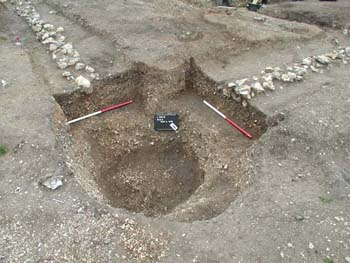Day 22: 29th July
Work has continued along the north-south street. This has taken the form of
disentangling the layers pre dating the late Roman buildings here. It has become
clear that there still remain layers dating to the late Roman period just north of
the southern trench edge. These layers consist of dumped rubbish deposits and they
are currently being removed to reveal the latest of many clay floor layers, presumably
to be associated with a building contemporary with the latest phase of House 1, and on
a similar alignment. This building promises to be a well built town house. Excavation
in this area concentrates on linking up the various layers identified to the latest
phases of House 1.
|
Day 23: 30th July
The sequence and story of House 1 becomes more absorbing each day.
We are able to detect the presence of an early core
of buildings probably of Iron Age date, beneath the
latest phase of House 1 (dated to the 2nd century AD).
These again appear to be flint founded walls with clay
and gravel floors. The extent of these buildings is not yet known. Examination of
the stratigraphy in the sides of the late Roman pits dug through the foundations of
House 1 suggests that these early buildings were levelled and covered by a bright
yellow clay into which was dug the latest phase of House 1. House 1 was a very
large town house with timberframed walls. It contained a central line of rooms with
clay make-up for gravel, flint and tesselated floors. At the far north-west end of
the House, a wooden beam slot has been indentified, which may have formed part of
the roof support for the later Roman building. It is apparent that this area of the
building was used for small scale industrial purposes – many interleaving burnt spreads.
To this latest phase of House 1 belongs the cupellation hearth indentified and
excavated in 1999.
Day 24 – 31st July
The well located in the north-west area of the site has finally been completed
after 12 weeks of excavation. Its final depth was about 2.5 metres. Right at
the base, the well cut narrowed to 70cm diameter and consisted of a shallow scoop
cut into soft bright yellow clay. No indication of a wooden lining, such as found
in a well last year, was found here. The fill of the well, however, produced waterlogged
material such as hazelnut shells which will be used for environmental analysis.
The wooden shoring which supported the sides of this well while excavation took
place has been removed and it will be transferred into our next candidate for
an early Roman well. The Late Roman rubbish pit filled with animal long bones
had subsided into this well.
Day 25 – 1st August
A quantity of late Roman deposits still remain along the line of the east-west Roman road.
In the main, these consist of complexes of Late Roman pits. These are being investigated.
Elsewhere the gully lining the road is being defined. A quantity of metal-working
debris such as iron slag was recovered from within one area of this gully, in the
north-east corner of the trench beneath the late Roman blacksmith’s building a number
of interlocking stoney and gritty layers have been revealed and are now being unpeeled.
|
Day 26 – 2nd August
Work continues within the house. Floor layers are being removed and their relationships
with the walls of the house examined. In some sections of the house, small trenches have
been opened up across the line of the walls with the aim of examining the depth of the
foundations of the walls and to ascertain the relationship of the various floors and walls
within the house.
|
Day 28 – 4th August
The trenches put across the walls of House 1 are providing valuable clues about the
development of the House.
|
| 
|
|
